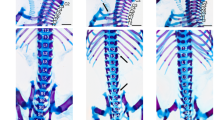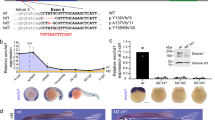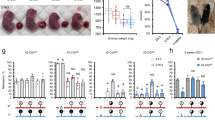Abstract
Mest (also known as Peg1), an imprinted gene expressed only from the paternal allele during development, was disrupted by gene targeting in embryonic stem (ES) cells. The targeted mutation is imprinted and reversibly silenced by passage through the female germ line. Paternal transmission activates the targeted allele and causes embryonic growth retardation associated with reduced postnatal survival rates in mutant progeny. More significantly, Mest-deficient females show abnormal maternal behaviour and impaired placentophagia, a distinctive mammalian behaviour. Our results provide evidence for the involvement of an imprinted gene in the control of adult behaviour.
This is a preview of subscription content, access via your institution
Access options
Subscribe to this journal
Receive 12 print issues and online access
$209.00 per year
only $17.42 per issue
Buy this article
- Purchase on Springer Link
- Instant access to full article PDF
Prices may be subject to local taxes which are calculated during checkout





Similar content being viewed by others
References
Ainscough, J.F.-X. & Surani, M.A. Organization and control of imprinted genes: the common features. in Epigenetic Mechanisms of Gene Regulation (eds Russo, V.E.A., Martienssen, R.A. & Riggs, A.D.) 173–194 (CSHL Press, New York, 1996).
John, R.M. & Surani, M.A. Imprinted genes and regulation of gene expression by epigenetic inheritance. Curr. Opin. Cell Biol. 8, 348–353 ( 1996).
Kaneko-Ishino, T. et al. Peg1/Mest imprinted gene on chromosome 6 identified by cDNA subtraction hybridization. Nature Genet. 11, 52–59 (1995).
Sado, T., Nakajima, N., Tada, M. & Takagi, N. A novel mesoderm-specific cDNA isolated from a mouse embryonal carcinoma cell line. Develop. Growth Differ. 35, 551–560 (1993).
Beechey, C.V. & Cattanach, B.M. Chromosome 6 and genetic imprinting . Mouse News Lett. 84, 82– 83 (1989).
Kobayashi, S. et al. Human PEG1/MEST, an imprinted gene on chromosome 7. Hum. Mol. Genet. 6, 781–786 (1997).
Nishita, Y., Yoshida, I., Sado, T. & Takagi, N. Genomic imprinting and chromosomal localization of the human MEST gene. Genomics 36, 539–542 ( 1996).
Riesewijk, A.M. et al. Monoallelic expression of human PEG1/MEST is paralleled by parent-specific methylation in fetuses. Genomics 42 , 236–244 (1997).
Spotila, L.D., Sereda, L. & Prockop, D.J. Partial isodisomy for maternal chromosome 7 and short stature in an individual with a mutation at the COL1A2 locus. Am. J. Hum. Genet. 51, 1396–1405 (1992).
Spence, NM>J.E. et al. Uniparental disomy as a mechanism for human genetic disease. Am. J. Hum. Genet. 42, 217–226 (1988).
Voss, R. et al. Isodisomy of chromosome 7 in a patient with cystic fibrosis: could uniparental disomy be common in humans? Am. J. Hum. Genet. 45, 373–380 ( 1989).
Lefebvre, L., Viville, S., Barton, S.C., Ishino, F. & Surani, M.A. Genomic structure and parent-of-origin-specific methylation of Peg1. Hum. Mol. Genet. 6, 1907–1915 (1997).
Tada, M., Tada, T., Lefebvre, L., Barton, S.C. & Surani, M.A. Embryonic germ cells induce epigenetic reprogramming of somatic nucleus in hybrid cells. EMBO J. 16, 6510–6520 (1997).
Mountford, P. et al. Dicistronic targeting constructs: Reporters and modifiers of mammalian gene expression. Proc. Natl Acad. Sci. USA 91, 4303–4307 (1994).
Nagy, A., Rossant, J., Nagy, R., Abramow-Newerly, W. & Roder, J.C. Derivation of completely cell culture-derived mice from early passage embryonic stem cells. Proc. Natl Acad. Sci. USA 90, 8424–8428 ( 1993).
Dickinson, C. & Keverne, E.B. Importance of noradrenergic mechanisms in the olfactory bulbs for the maternal behaviour of mice. Physiol. Behav. 43, 313–316 ( 1988).
Ledbetter, D.H. & Engel, E. Uniparental disomy in humans: development of an imprinting map and its implications for prenatal diagnosis. Hum. Mol. Genet. 4, 1757– 1764 (1995).
Hoglund, P., Holmberg, C., de la Chapelle, A. & Kere, J. Paternal isodisomy for chromosome 7 is compatible with normal growth and development in a patient with congenital chloride diarrhea. Am. J. Hum. Genet. 55, 747–752 ( 1994).
Langlois, S., Yong, S.L., Wilson, R.D., Kwong, L.C. & Kalousek, D.K. Prenatal and postnatal growth failure associated with maternal heterodisomy for chromosome 7. J. Med. Genet. 32, 871–875 (1995).
Patton, M.A. Russell-Silver syndrome. J. Med. Genet. 25, 557–560 (1988).
Eggermann, T. et al. Molecular studies in 37 Silver-Russell syndrome patients: frequency and etiology of uniparental disomy. Hum. Genet. 100, 415–419 (1997).
Kotzot, D. et al. Uniparental disomy 7 in Silver-Russell syndrome and primordial growth retardation. Hum. Mol. Genet. 4, 583–587 (1995).
Preece, M.A. et al. Maternal uniparental disomy 7 in Silver-Russell syndrome. J. Med. Genet. 34, 6–9 ( 1997).
Miyoshi, N. et al. Identification of the Meg1/Grb10 imprinted gene on mouse proximal chromosome 11, a candidate for the Silver-Russell syndrome gene. Proc. Natl Acad. Sci. USA 95, 1102– 1107 (1998).
Moore, T. & Haig, D. Genomic imprinting in mammalian development: a parental tug-of-war. Trends Genet. 7, 45–49 (1991).
Haig, D. & Graham, C. Genomic imprinting and the strange case of the insulin-like growth factor II receptor. Cell 64, 1045–1046 (1991).
DeChiara, T.M., Robertson, E.J. & Efstratiadis, A. Parental imprinting of the mouse insulin-like growth factor II gene. Cell 64, 849– 859 (1991).
Numan, M. A neural circuity analysis of maternal behavior in the rat. Acta Paediatr. Suppl. 397, 19–28 (1994).
Kristal, M.B. Enhancement of opioid-mediated analgesia: a solution to the enigma of placentophagia . Neurosci. Biobehav. Rev. 15, 425– 435 (1991).
Bernardis, L.L. & Bellinger, L.L. The lateral hypothalamic area revisited: ingestive behavior. Neurosci. Biobehav. Rev. 20, 189–287 ( 1996).
Franz, J.R., Leo, R.J., Steuer, M.A. & Kristal, M.B. Effects of hypothalamic knife cuts and experience on maternal behavior in the rat. Physiol. Behav. 38, 629–640 ( 1986).
Brown, J.R., Ye, H., Bronson, R.T., Dikkes, > & Greenberg, M.E. A defect in nurturing in mice lacking the immediate early gene fosB. Cell 86, 297–309 ( 1996).
Thomas, S.A. & Palmiter, R.D. Impaired maternal behavior in mice lacking norepinephrine and epinephrine. Cell 91 , 583–592 (1997).
Fundele, R.H. & Surani, M.A. Experimental embryological analysis of genetic imprinting in mouse development. Dev. Genet. 15, 515–522 (1994).
Allen, N.D. et al. Distribution of parthenogenetic cells in the mouse brain and their influence on brain development and behavior. Proc. Natl Acad. Sci. USA 92, 10782–10786 (1995).
Cattanach, B.M. & Beechey, C.V. Autosomal and X-chromosome imprinting. Dev. Suppl. 63– 72 (1990).
Cattanach, B.M. et al. A candidate model for Angelman syndrome in the mouse. Mamm. Genome 8, 472–478 (1997).
Holm, V.A. et al. Prader-Willi syndrome: consensus diagnostic criteria. Pediatrics 91, 398–402 ( 1993).
Williams, C.A. et al. Angelman syndrome: consensus for diagnostic criteria. Am. J. Med. Genet. 56, 237–238 (1995).
Lathe, R., Vilotte, J.L. & Clark, A.J. Plasmid and bacteriophage vectors for excision of intact inserts. Gene 57, 193– 201 (1987).
Friedrich, G. & Soriano, P. Promoter traps in embryonic stem cells: a genetic screen to identify and mutate developmental genes in mice Genes Dev. 5, 1513–1523 (1991).
Kikyo, N. et al. Genetic and functional analysis of neuronatin in mice with maternal or paternal duplication of distal chr 2. Dev. Biol. 190, 66–77 (1997).
Acknowledgements
We thank the members of our group for their help, especially J. Ainscough and R. John for their valuable comments on this work, J. Dixon for the IRES-βgeo construct pIFS and A. Nagy for the R1 ES cells. This work was supported by a grant from the Wellcome Trust to M.A.S. L.L. was a Research Fellow of the National Cancer Institute of Canada, supported with funds provided by the Terry Fox Run, and S.V. was supported by a Fellowship from EMBO.
Author information
Authors and Affiliations
Corresponding author
Rights and permissions
About this article
Cite this article
Lefebvre, L., Viville, S., Barton, S. et al. Abnormal maternal behaviour and growth retardation associated with loss of the imprinted gene Mest. Nat Genet 20, 163–169 (1998). https://doi.org/10.1038/2464
Received:
Accepted:
Issue Date:
DOI: https://doi.org/10.1038/2464
This article is cited by
-
Marsupials have monoallelic MEST expression with a conserved antisense lncRNA but MEST is not imprinted
Heredity (2024)
-
Neurotrophin-3 from the dentate gyrus supports postsynaptic sites of mossy fiber-CA3 synapses and hippocampus-dependent cognitive functions
Molecular Psychiatry (2024)
-
Conservation and divergence of canonical and non-canonical imprinting in murids
Genome Biology (2023)
-
α1,3-fucosylation of MEST promotes invasion potential of cytotrophoblast cells by activating translation initiation
Cell Death & Disease (2023)
-
Imprinted genes and the manipulation of parenting in mammals
Nature Reviews Genetics (2023)



